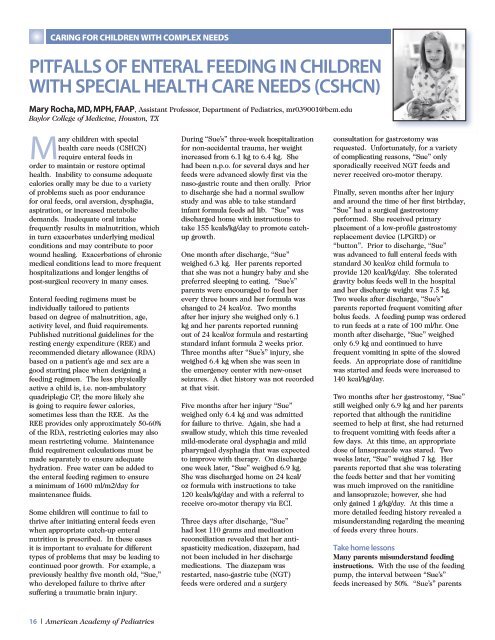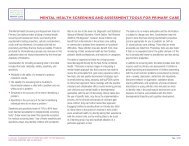Susan Wu, MD, FAAP, Editor - American Academy of Pediatrics
Susan Wu, MD, FAAP, Editor - American Academy of Pediatrics
Susan Wu, MD, FAAP, Editor - American Academy of Pediatrics
Create successful ePaper yourself
Turn your PDF publications into a flip-book with our unique Google optimized e-Paper software.
CariNG for ChiLDreN With ComPLex NeeDS<br />
PITFALLS OF ENTERAL FEEDING IN CHILDREN<br />
WITH SPECIAL HEALTH CARE NEEDS (CSHCN)<br />
Mary Rocha, <strong>MD</strong>, MPH, <strong>FAAP</strong>, Assistant Pr<strong>of</strong>essor, Department <strong>of</strong> <strong>Pediatrics</strong>, mr039001@bcm.edu<br />
Baylor College <strong>of</strong> Medicine, Houston, TX<br />
Many children with special<br />
health care needs (CSHCN)<br />
require enteral feeds in<br />
order to maintain or restore optimal<br />
health. Inability to consume adequate<br />
calories orally may be due to a variety<br />
<strong>of</strong> problems such as poor endurance<br />
for oral feeds, oral aversion, dysphagia,<br />
aspiration, or increased metabolic<br />
demands. Inadequate oral intake<br />
frequently results in malnutrition, which<br />
in turn exacerbates underlying medical<br />
conditions and may contribute to poor<br />
wound healing. Exacerbations <strong>of</strong> chronic<br />
medical conditions lead to more frequent<br />
hospitalizations and longer lengths <strong>of</strong><br />
post-surgical recovery in many cases.<br />
Enteral feeding regimens must be<br />
individually tailored to patients<br />
based on degree <strong>of</strong> malnutrition, age,<br />
activity level, and fluid requirements.<br />
Published nutritional guidelines for the<br />
resting energy expenditure (REE) and<br />
recommended dietary allowance (RDA)<br />
based on a patient’s age and sex are a<br />
good starting place when designing a<br />
feeding regimen. The less physically<br />
active a child is, i.e. non-ambulatory<br />
quadriplegic CP, the more likely she<br />
is going to require fewer calories,<br />
sometimes less than the REE. As the<br />
REE provides only approximately 50-60%<br />
<strong>of</strong> the RDA, restricting calories may also<br />
mean restricting volume. Maintenance<br />
fluid requirement calculations must be<br />
made separately to ensure adequate<br />
hydration. Free water can be added to<br />
the enteral feeding regimen to ensure<br />
a minimum <strong>of</strong> 1600 ml/m2/day for<br />
maintenance fluids.<br />
Some children will continue to fail to<br />
thrive after initiating enteral feeds even<br />
when appropriate catch-up enteral<br />
nutrition is prescribed. In these cases<br />
it is important to evaluate for different<br />
types <strong>of</strong> problems that may be leading to<br />
continued poor growth. For example, a<br />
previously healthy five month old, “Sue,”<br />
who developed failure to thrive after<br />
suffering a traumatic brain injury.<br />
16 | <strong>American</strong> <strong>Academy</strong> <strong>of</strong> <strong>Pediatrics</strong><br />
During “Sue’s” three-week hospitalization<br />
for non-accidental trauma, her weight<br />
increased from 6.1 kg to 6.4 kg. She<br />
had been n.p.o. for several days and her<br />
feeds were advanced slowly first via the<br />
naso-gastric route and then orally. Prior<br />
to discharge she had a normal swallow<br />
study and was able to take standard<br />
infant formula feeds ad lib. “Sue” was<br />
discharged home with instructions to<br />
take 155 kcals/kg/day to promote catchup<br />
growth.<br />
One month after discharge, “Sue”<br />
weighed 6.3 kg. Her parents reported<br />
that she was not a hungry baby and she<br />
preferred sleeping to eating. “Sue’s”<br />
parents were encouraged to feed her<br />
every three hours and her formula was<br />
changed to 24 kcal/oz. Two months<br />
after her injury she weighed only 6.1<br />
kg and her parents reported running<br />
out <strong>of</strong> 24 kcal/oz formula and restarting<br />
standard infant formula 2 weeks prior.<br />
Three months after “Sue’s” injury, she<br />
weighed 6.4 kg when she was seen in<br />
the emergency center with new-onset<br />
seizures. A diet history was not recorded<br />
at that visit.<br />
Five months after her injury “Sue”<br />
weighed only 6.4 kg and was admitted<br />
for failure to thrive. Again, she had a<br />
swallow study, which this time revealed<br />
mild-moderate oral dysphagia and mild<br />
pharyngeal dysphagia that was expected<br />
to improve with therapy. On discharge<br />
one week later, “Sue” weighed 6.9 kg.<br />
She was discharged home on 24 kcal/<br />
oz formula with instructions to take<br />
120 kcals/kg/day and with a referral to<br />
receive oro-motor therapy via ECI.<br />
Three days after discharge, “Sue”<br />
had lost 110 grams and medication<br />
reconciliation revealed that her antispasticity<br />
medication, diazepam, had<br />
not been included in her discharge<br />
medications. The diazepam was<br />
restarted, naso-gastric tube (NGT)<br />
feeds were ordered and a surgery<br />
consultation for gastrostomy was<br />
requested. Unfortunately, for a variety<br />
<strong>of</strong> complicating reasons, “Sue” only<br />
sporadically received NGT feeds and<br />
never received oro-motor therapy.<br />
Finally, seven months after her injury<br />
and around the time <strong>of</strong> her first birthday,<br />
“Sue” had a surgical gastrostomy<br />
performed. She received primary<br />
placement <strong>of</strong> a low-pr<strong>of</strong>ile gastrostomy<br />
replacement device (LPGRD) or<br />
“button”. Prior to discharge, “Sue”<br />
was advanced to full enteral feeds with<br />
standard 30 kcal/oz child formula to<br />
provide 120 kcal/kg/day. She tolerated<br />
gravity bolus feeds well in the hospital<br />
and her discharge weight was 7.5 kg.<br />
Two weeks after discharge, “Sue’s”<br />
parents reported frequent vomiting after<br />
bolus feeds. A feeding pump was ordered<br />
to run feeds at a rate <strong>of</strong> 100 ml/hr. One<br />
month after discharge, “Sue” weighed<br />
only 6.9 kg and continued to have<br />
frequent vomiting in spite <strong>of</strong> the slowed<br />
feeds. An appropriate dose <strong>of</strong> ranitidine<br />
was started and feeds were increased to<br />
140 kcal/kg/day.<br />
Two months after her gastrostomy, “Sue”<br />
still weighed only 6.9 kg and her parents<br />
reported that although the ranitidine<br />
seemed to help at first, she had returned<br />
to frequent vomiting with feeds after a<br />
few days. At this time, an appropriate<br />
dose <strong>of</strong> lansoprazole was stared. Two<br />
weeks later, “Sue” weighed 7 kg. Her<br />
parents reported that she was tolerating<br />
the feeds better and that her vomiting<br />
was much improved on the ranitidine<br />
and lansoprazole; however, she had<br />
only gained 1 g/kg/day. At this time a<br />
more detailed feeding history revealed a<br />
misunderstanding regarding the meaning<br />
<strong>of</strong> feeds every three hours.<br />
Take home lessons<br />
Many parents misunderstand feeding<br />
instructions. With the use <strong>of</strong> the feeding<br />
pump, the interval between “Sue’s”<br />
feeds increased by 50%. “Sue’s” parents



